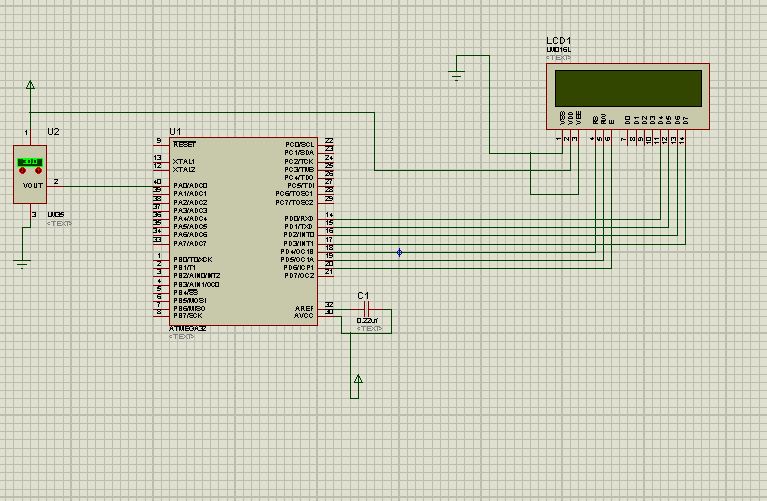In this new tutorial, we will be interfacing an LM35-based temperature sensor with ATMEGA32. The three main types are thermometers, resistance temperature detectors, and thermocouples. All three of these sensors measure a physical property (i.e., the volume of a liquid, current through a wire), which changes as a function of temperature. In addition to the three main types of temperature sensors, there are numerous other temperature sensors available for use.
However, the LM35-based sensors are precision-integrated temperature sensors with an output voltage linearly proportional to the Centigrade temperature. The main advantage is these types of sensors don’t require any external calibration. They are internally calibrated and simply generate the output to the temperature they detect. The device is used with single power supplies or with plus and minus supplies. As the LM35 draws only 60 μA from the supply, it has very low self-heating of less than 0.1°C in still air. The LM35 is rated to operate over a −55°C to +150°C temperature range, while the LM35C is rated for a −40°C to +110°C range (−10° with improved accuracy). The National Instrument initially manufactured LM35 series of a temperature sensor, but in the current scenario, almost every semiconductor company manufacture LM35 based temperature sensor.
Before starting with the coding part, ensure you have adequate knowledge about using ADC of AVR. Since we will display the temperature on a character LCD, ensure you have reviewed the LCD tutorial posted on the website.
The sensitivity of LM35 is 10 millivolts per °C. Sensitivity, in layman’s terms, is the ratio of output by the input. So if the surrounding temperature is 1°C then its output will be 10mv, or if the temperature is 31°C, then the output will be 310mv. The AVR can easily detect these small voltages after converting them into ADC, and by doing a certain amount of calculation; we can get back the temperature. Again the LM35 series of sensors are available in both analog and digital forms. We will be using the analog temperature sensor.
Since we are using the ADC in 10-bit mode with a reference voltage of 5V supplied externally, the maximum ADC value can be 1023, and the minimum can be 0. The resolution in terms of voltage can be:-
5/1023=4.88mV
If the ADC reading is 10 it means the input voltage is 48.8mV. With a sensitivity of 10mv °C, this accounts for 4.8°C temperature of the surrounding. So for a particular ADC value, we will have to divide by 2.04 (10/4.88) to get the temperature. For the sake of simplicity, we will be dividing by 2.
Also, I am using the AVR on a 16MHz clock crystal, and the ADC prescaler have been set accordingly. So if you decide to use some other crystal frequency or even internal ADC, make sure you make the necessary changes in the ADC prescalar.
Circuit Diagram:
Source Code
#ifndef F_CPU
#define F_CPU 1600000UL
#endif
#include <avr/io.h>
#include <util/delay.h>
#include "lcd.h"
void adc_init()
{
// AREF = AVcc
ADMUX = (1<<REFS0);
// ADC Enable and prescaler of 128
ADCSRA = (1<<ADEN)|(1<<ADPS2)|(1<<ADPS1)|(1<<ADPS0);
}
// read adc value
uint16_t adc_read(uint8_t ch)
{
// select the corresponding channel 0~7
ch &= 0b00000111; // AND operation with 7
ADMUX = (ADMUX & 0xF8)|ch;
// start single conversion
// write '1' to ADSC
ADCSRA |= (1<<ADSC);
// wait for conversion to complete
// ADSC becomes '0' again
while(ADCSRA & (1<<ADSC));
return (ADC);
}
int main()
{
uint16_t adc_result0;
int temp;
char buffer[10];
// initialize adc and lcd
adc_init();
lcd_init(LCD_DISP_ON_CURSOR);
lcd_clrscr();
lcd_gotoxy(0,0);
_delay_ms(50);
while(1)
{
adc_result0 = adc_read(0); // read adc value at PA0
temp=adc_result0/2.0; // finding the temperature
lcd_gotoxy(0,0);
lcd_puts("Adc=");
itoa(adc_result0,buffer,10); //display ADC value
lcd_puts(buffer);
lcd_gotoxy(0,1);
itoa(temp,buffer,10);
lcd_puts("Temperature="); //display temperature
lcd_puts(buffer);
_delay_ms(50);
}
}
Download project files here: temperature_sensor




hi, i did it with a 7segment display made of component leds.
But the temperature conversion is taking place only once.If i switch it off and on then only the temperature is changing.I want to send you the code to check it. please revert me in mail.